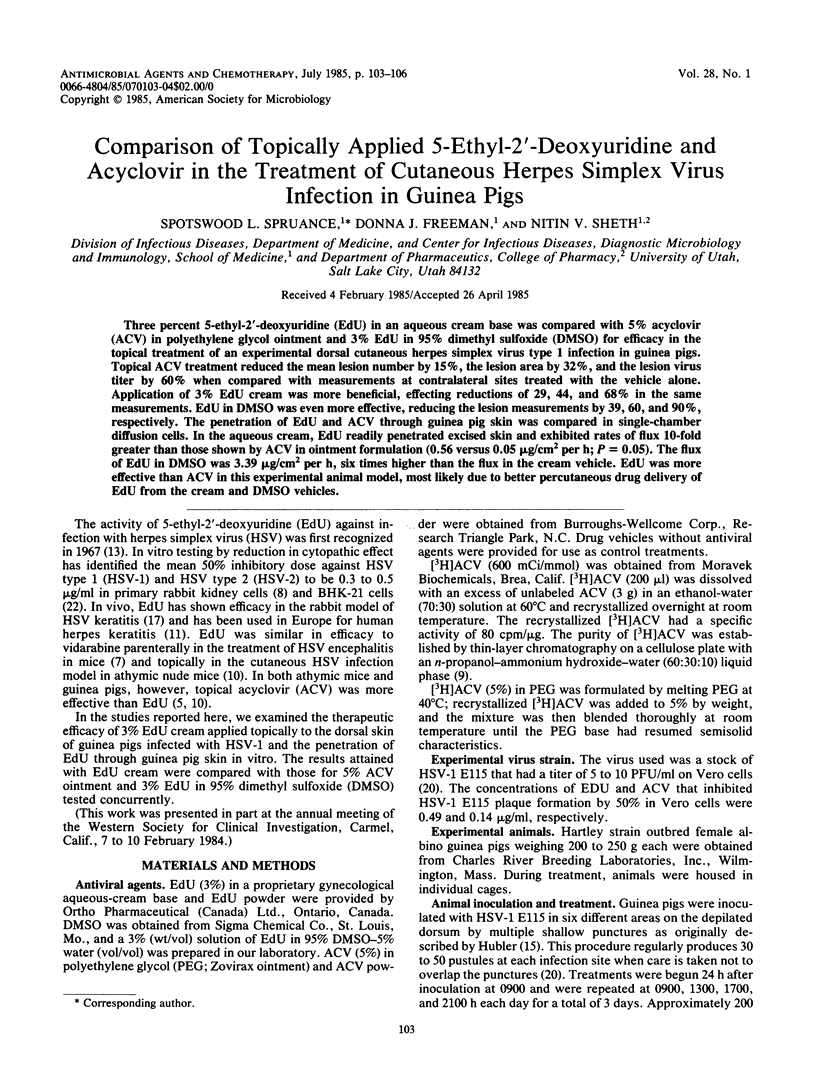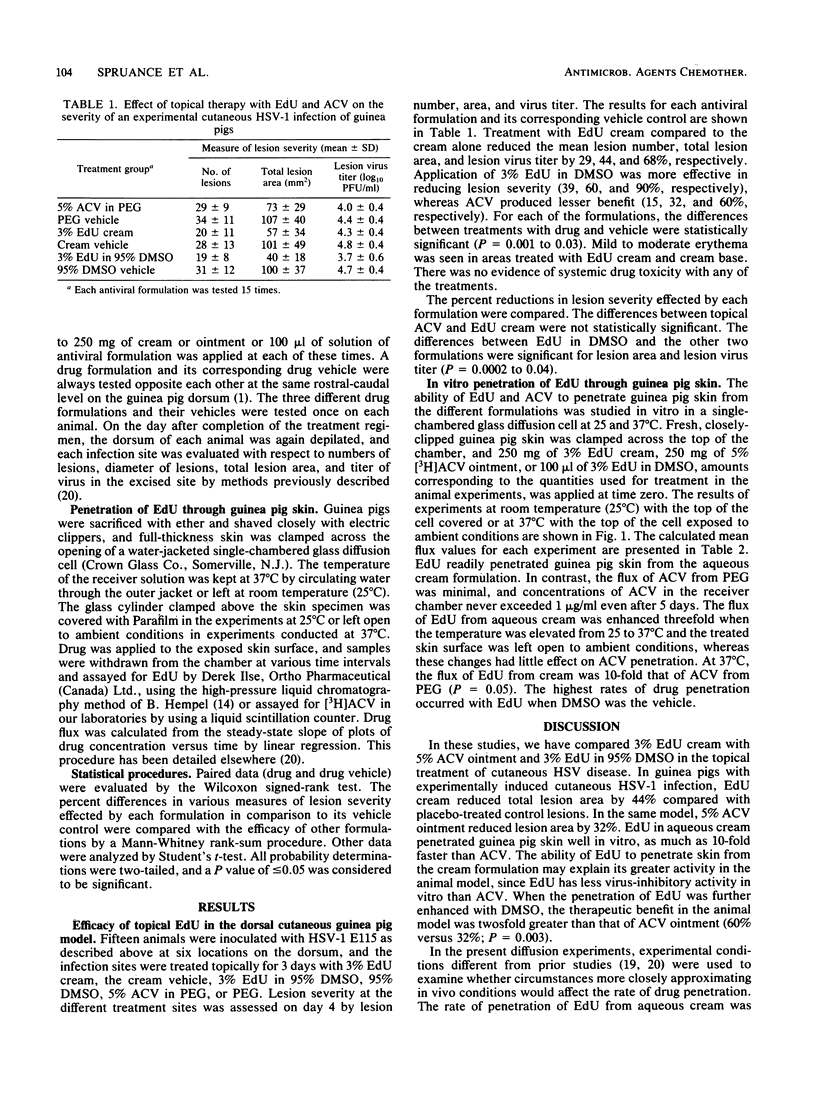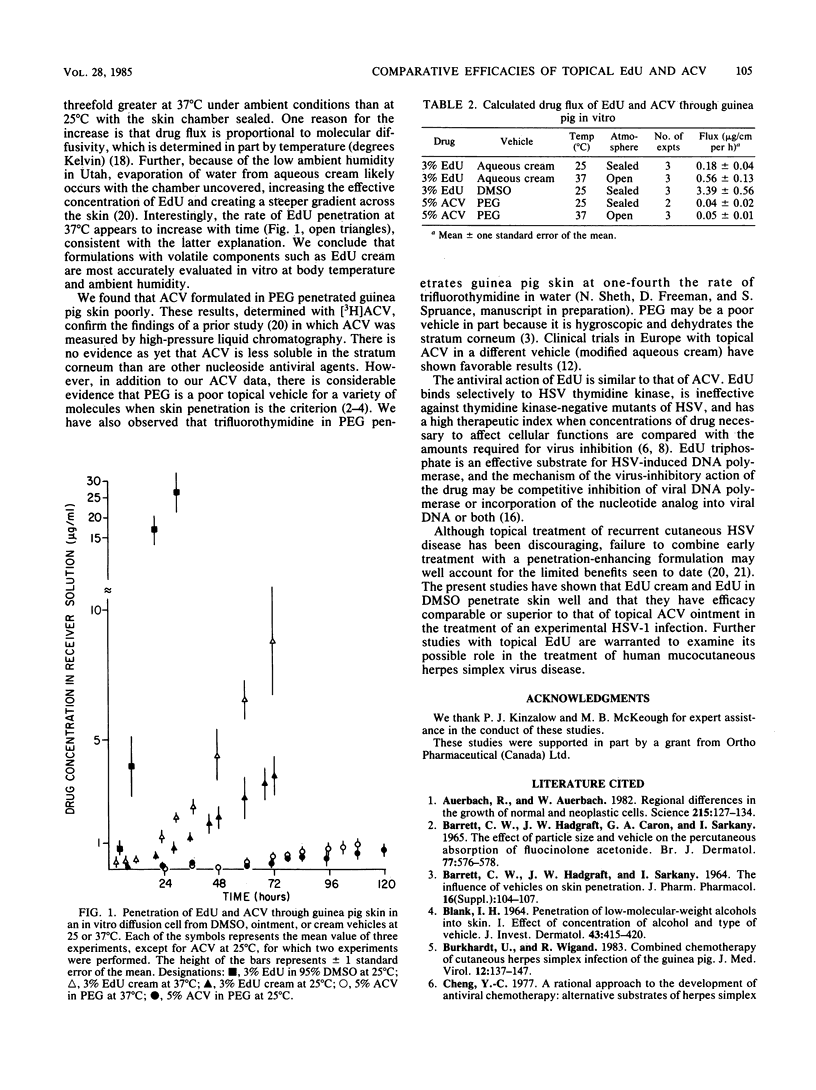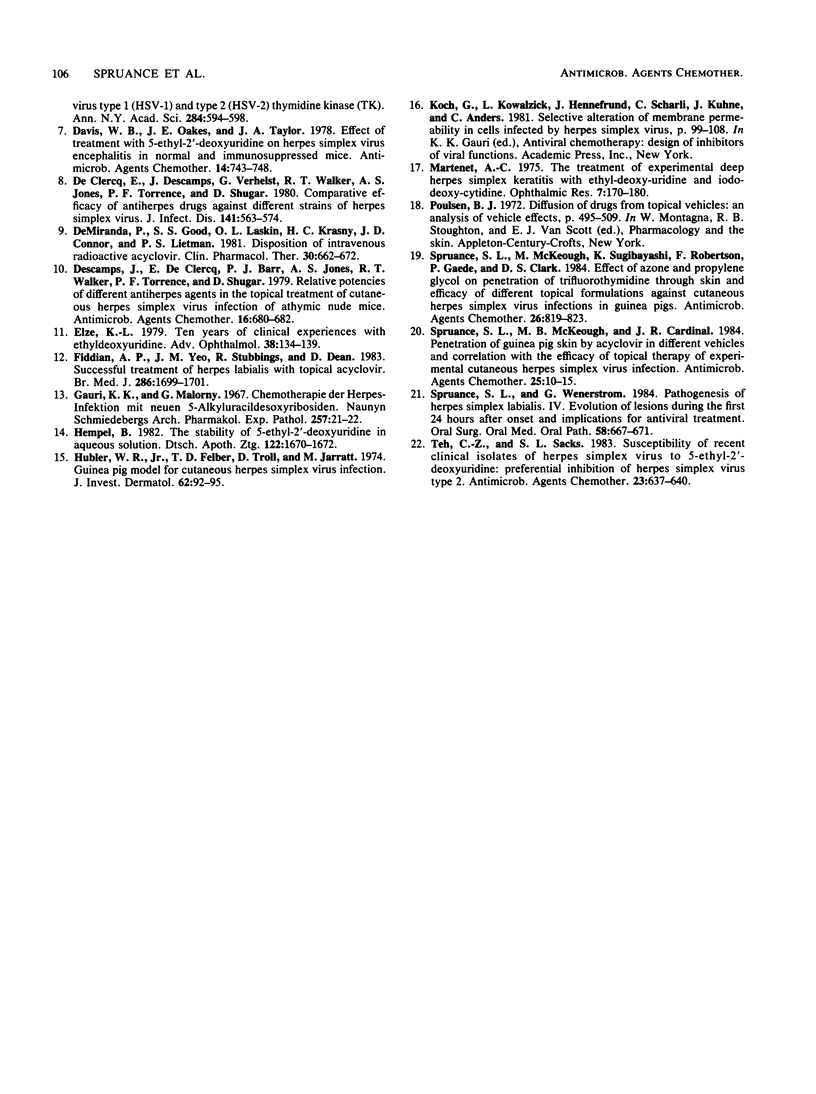Abstract
Three percent 5-ethyl-2'-deoxyuridine (EdU) in an aqueous cream base was compared with 5% acyclovir (ACV) in polyethylene glycol ointment and 3% EdU in 95% dimethyl sulfoxide (DMSO) for efficacy in the topical treatment of an experimental dorsal cutaneous herpes simplex virus type 1 infection in guinea pigs. Topical ACV treatment reduced the mean lesion number by 15%, the lesion area by 32%, and the lesion virus titer by 60% when compared with measurements at contralateral sites treated with the vehicle alone. Application of 3% EdU cream was more beneficial, effecting reductions of 29, 44, and 68% in the same measurements. EdU in DMSO was even more effective, reducing the lesion measurements by 39, 60, and 90%, respectively. The penetration of EdU and ACV through guinea pig skin was compared in single-chamber diffusion cells. In the aqueous cream, EdU readily penetrated excised skin and exhibited rates of flux 10-fold greater than those shown by ACV in ointment formulation (0.56 versus 0.05 microgram/cm2 per h; P = 0.05). The flux of EdU in DMSO was 3.39 micrograms/cm2 per h, six times higher than the flux in the cream vehicle. EdU was more effective than ACV in this experimental animal model, most likely due to better percutaneous drug delivery of EdU from the cream and DMSO vehicles.
Full text
PDF



Selected References
These references are in PubMed. This may not be the complete list of references from this article.
- Auerbach R., Auerbach W. Regional differences in the growth of normal and neoplastic cells. Science. 1982 Jan 8;215(4529):127–134. doi: 10.1126/science.7053564. [DOI] [PubMed] [Google Scholar]
- BARRETT C. W., HADGRAFT J. W., SARKANY I. THE INFLUENCE OF VEHICLES ON SKIN PENETRATION. J Pharm Pharmacol. 1964 Dec;16:SUPPL–SUPPL:17T. doi: 10.1111/j.2042-7158.1964.tb07545.x. [DOI] [PubMed] [Google Scholar]
- BLANK I. H. PENETRATION OF LOW-MOLECULAR-WEIGHT ALCOHOLS INTO SKIN. I. EFFECT OF CONCENTRATION OF ALCOHOL AND TYPE OF VEHICLE. J Invest Dermatol. 1964 Nov;43:415–420. doi: 10.1038/jid.1964.174. [DOI] [PubMed] [Google Scholar]
- Barrett C. W., Hadgraft J. W., Caron G. A., Sarkany I. The effect of particle size and vehicle on the percutaneous absorption of fluocinolone acetonide. Br J Dermatol. 1965 Nov;77(11):576–578. doi: 10.1111/j.1365-2133.1965.tb14578.x. [DOI] [PubMed] [Google Scholar]
- Burkhardt U., Wigand R. Combined chemotherapy of cutaneous herpes simplex infection of the guinea pig. J Med Virol. 1983;12(2):137–147. doi: 10.1002/jmv.1890120208. [DOI] [PubMed] [Google Scholar]
- Davis W. B., Oakes J. E., Taylor J. A. Effect of treatment with 5-ethyl-2'-deoxyuridine on herpes simplex virus encephalitis in normal and immunosuppressed mice. Antimicrob Agents Chemother. 1978 Nov;14(5):743–748. doi: 10.1128/aac.14.5.743. [DOI] [PMC free article] [PubMed] [Google Scholar]
- De Clercq E., Descamps J., Verhelst G., Walker R. T., Jones A. S., Torrence P. F., Shugar D. Comparative efficacy of antiherpes drugs against different strains of herpes simplex virus. J Infect Dis. 1980 May;141(5):563–574. doi: 10.1093/infdis/141.5.563. [DOI] [PubMed] [Google Scholar]
- Descamps J., De Clercq E., Barr P. J., Jones A. S., Walker R. T., Torrence P. F., Shugar D. Relative potencies of different anti-herpes agents in the topical treatment of cutaneous herpes simplex virus infection of athymic nude mice. Antimicrob Agents Chemother. 1979 Nov;16(5):680–682. doi: 10.1128/aac.16.5.680. [DOI] [PMC free article] [PubMed] [Google Scholar]
- Elze K. L. Ten years of clinical experiences with ethyldeoxyuridine. Adv Ophthalmol. 1979;38:134–139. [PubMed] [Google Scholar]
- Fiddian A. P., Yeo J. M., Stubbings R., Dean D. Successful treatment of herpes labialis with topical acyclovir. Br Med J (Clin Res Ed) 1983 May 28;286(6379):1699–1701. doi: 10.1136/bmj.286.6379.1699. [DOI] [PMC free article] [PubMed] [Google Scholar]
- Gauri K. K., Malorny G. Chemotherapie der Herpes-Infektion mit neuen 5-Alkyluracildesoxyribosiden. Naunyn Schmiedebergs Arch Exp Pathol Pharmakol. 1967;257(1):21–22. [PubMed] [Google Scholar]
- Hubler W. R., Jr, Felber T. D., Troll D., Jarratt M. Guinea pig model for cutaneous herpes simplex virus infection. J Invest Dermatol. 1974 Feb;62(2):92–95. doi: 10.1111/1523-1747.ep12692222. [DOI] [PubMed] [Google Scholar]
- Poulsen B. J. Diffusion of drugs from topical vehicles: an analysis of vehicle effects. Adv Biol Skin. 1972;12:495–509. [PubMed] [Google Scholar]
- Spruance S. L., McKeough M. B., Cardinal J. R. Penetration of guinea pig skin by acyclovir in different vehicles and correlation with the efficacy of topical therapy of experimental cutaneous herpes simplex virus infection. Antimicrob Agents Chemother. 1984 Jan;25(1):10–15. doi: 10.1128/aac.25.1.10. [DOI] [PMC free article] [PubMed] [Google Scholar]
- Spruance S. L., McKeough M., Sugibayashi K., Robertson F., Gaede P., Clark D. S. Effect of azone and propylene glycol on penetration of trifluorothymidine through skin and efficacy of different topical formulations against cutaneous herpes simplex virus infections in guinea pigs. Antimicrob Agents Chemother. 1984 Dec;26(6):819–823. doi: 10.1128/aac.26.6.819. [DOI] [PMC free article] [PubMed] [Google Scholar]
- Spruance S. L., Wenerstrom G. Pathogenesis of recurrent herpes simplex labialis. IV. Maturation of lesions within 8 hours after onset and implications for antiviral treatment. Oral Surg Oral Med Oral Pathol. 1984 Dec;58(6):667–671. doi: 10.1016/0030-4220(84)90031-8. [DOI] [PubMed] [Google Scholar]
- Teh C. Z., Sacks S. L. Susceptibility of recent clinical isolates of herpes simplex virus to 5-ethyl-2'-deoxyuridine: preferential inhibition of herpes simplex virus type 2. Antimicrob Agents Chemother. 1983 May;23(5):637–640. doi: 10.1128/aac.23.5.637. [DOI] [PMC free article] [PubMed] [Google Scholar]
- de Miranda P., Good S. S., Laskin O. L., Krasny H. C., Connor J. D., Lietman P. S. Disposition of intravenous radioactive acyclovir. Clin Pharmacol Ther. 1981 Nov;30(5):662–672. doi: 10.1038/clpt.1981.218. [DOI] [PubMed] [Google Scholar]


